SIFU WONG KIEW KIT'S HOME PAGE
WAHNAM TAIJIQUAN IN PICTURES SERIES
GRASPING SPARROW'S TAIL
THE MECHANICS OF TAIJIQUAN MOVEMENTS
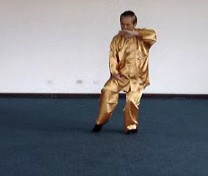
Sifu Wong performing Grasping Sparrow's Tail movements
Why is "Grasping Sparrow's Tail" so important in Taijiquan? It is because this one pattern incorporates all the fundamental requirements of Taijiquan, including
-
differentiating yin-yang
-
stances
-
footwork
-
waist movement
-
body movement
-
hand movement
-
basic techniques
-
generating energy flow
-
developing internal force
-
combat application
I am not sure whether Yang Lu Chan or his grandson, Yang Deng Fu, invented "Grasping Sparrow's Tail" by combining some basic techniques in Chen Style Taijiquan into one pattern. Whoever he was, we are greatly indebted to him.
If you have some internal force and good footwork, by just using "Grasping Sparrow's Tail" you can counter any forms of attacks, regardless of strikes, kicks, felling techniques or grips! On the other hand, if you are beginning to learn Taijiquan, "Grasping Sparrow's Tail" will provide you the means to learn the basic mechanics of Taijiquan movements, such as how to start from you back leg, move from you waist, and conclude the movement at the front hand, which manifests the three external harmonies of leg, body and hand.
It is reputed that Yang Lu Chan practiced “Grasping Sparrow's Tail†thousands of times daily. But I believe "Grasping Sparrow's Tail" was not formalized yet; what he performed were undefined flowing movements poetically described as "Flowing Water, Floating Clouds", shortened to "Cloud Hands". For the convenience of teaching, these movements were gradually formalized and defined into "Grasping Sparrow's Tail".
Traditionally, “Grasping Sparrow's Tail†is said to be composed of four fundamental techniques — “peng†or ward off, “lu†or roll back, “qi†or press forward, and “an†or push. But we in Shaolin Wahnam identify a fifth technique, “chen†or sink back, between â€qi†and “anâ€. And we name the patterns that implement the techniques as follows:
-
Peng or Ward Off — Immortal Waves Sleeves
-
Lu or Roll Back — Double Dragons Play with Pearl
-
Qi or Press Forward — Push Boat According to Flow of Stream
-
Chen or Sink Back — Black Bear Sinks Hips
-
An or Push — Push Open Window to Look at Moon
The following pictures are culled from a video clip taken at the VIP Taijiquan Course on top of the Andes Mountains in September 2005. Amongst other things, these pictures show how you should adjust your foot position, transfer your body weight, turn your waist to lead your body, and follow through with your hands — the mechanics of the three external harmonies.
If you can perform “Grasping Sparrow's Tail†well, performing all other Taijiquan patterns with grace, elegance and balance will be relatively easy. When these external harmonies of legs, body and hands are correct, cultivation of essence, energy and mind — the three internal harmonies — as well as combat application will be enhanced.
Peng — Immortal Waves Sleeves
Take note of the following:
-
Differentiate yin-yang. Initially the body weight is on the left leg, gradually the weight is transferred and effectually the weight is evenly distributed on both legs. Would this be a weakness of double yang. No. When the weight is even distributed, yin and yang do not represent left and right, but stability and agility.
-
The transfer of weight as well as all other movements are controlled by the waist.
-
The actual movement of the hands is little. Much of the movement of the right hand from Photo 1 to Photo 10 is due not to its own movement but to the turning of the waist. In other words, even if you did not move your hands, the hand position would have moved considerably because you have turned your body from your waist. The hand does move, but only a little as part of the continuous movement started at the back leg.

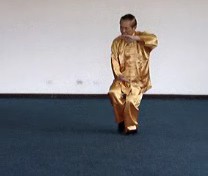
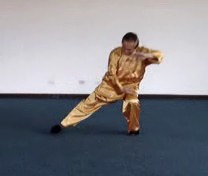
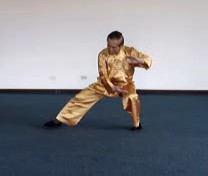
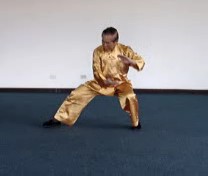


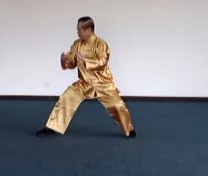
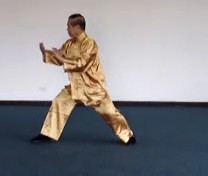

Lu — Double Dragons Play with Pearl
Take note of the following:
-
There is no stopping at “pengâ€; the movement continues to “luâ€, though there may be one for learning purposes. The transitional movement from “peng†to “lu†is a rounded turn, not an abrupt turn-about, so that there is no break in both the physical movement and the energy flow.
-
As in “peng†before, the roll-back movement is due to the turning of the waist, and not the movement of the hands themselves. The hand movement is little, coming towards the end where the continuous movement turns into the next technique, “qiâ€.
-
The roll-back movement results in “hua†or “neutralizing an opponent's attackâ€, commonly referred to in Taijiquan literature in English as “yieldingâ€. Notice the stance, especially the positions of the legs and the body, where the exponent is still very stable (and agile) in his “yieldingâ€. A common mistake is to lean backward, resulting in an wakward position where both stability and agility are lost.
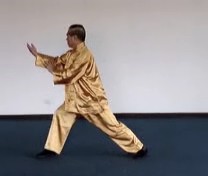
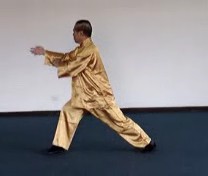
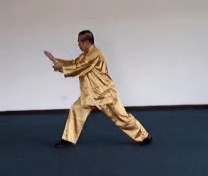
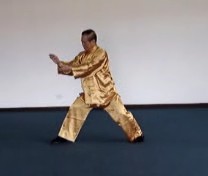
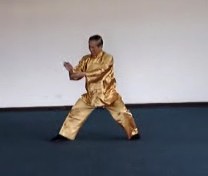
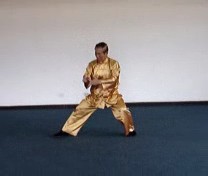
Qi — Push Boat According to Flow of Stream
Take note of the following:
-
-
The push is from the back leg, not from the hands or shoulders. At the physical level, the push is sometimes described as with whole-body weight. This is often interpreted by some schools and some masters to mean that the exponent transfers much of his body weight to his front leg, and throws his body forward.
In Shaolin Wahnam we interpret this differently. Body-weight is used not by throwing the body forward but by moving the waist. The weight transfer from the back leg to the front leg is from about 90-10 to 50-50, or if needed 45-55, so that at the completion of the push the body weight is quite evenly distributed between the two legs. Notice that the front knee does not go beyond the from toes. Is this a weakness of double-yang? No. As mentioned earlier, yin-yang here represents stability and agility. In fact in our school, throwing much of the body weight over the front leg and leaning the body forward to add momentum would be a weakness of double yang. It is also injurious to the front knee and the ankle. Instead of using body-weight, we can use internal force. In this case the body weight should be evenly distributed between the legs.
-
Not many people may realize that this “pressing†technique is more significantly used as “qin-na†to dislocate an opponent's wrist.
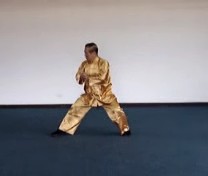
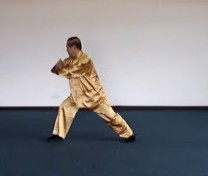
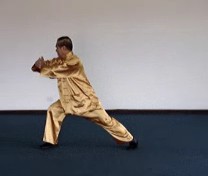
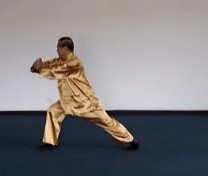
Chen — Black Bear Sinks Hips
Take note of the following:
-
The “sinking†is not effected by pushing the hands down or bending the body forward, which are common mistakes, but by lowering the stance.
-
The “sinking†movement results in “hua†or “yieldingâ€. Another common mistake to avoid is to lean the body backward, which also results in stress on the back, knee and ankle.
-
This “sinking†technique enable you to be very stable, as your chi sinks to your abdominal dan tian, but you must also be agile at the same time. It is very important not to force the chi to sink. Doing so may result in harmful side effect. Let the chi sink naturally.

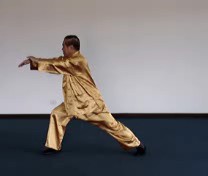
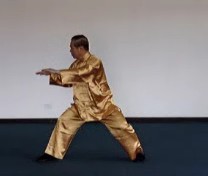

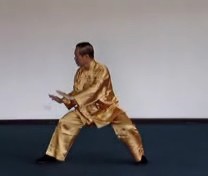

An — Push Open Window to Look at Moon
Take note of the following:
-
As in “qi†above, the body weight is evenly distributed between the two legs at the completion of “anâ€, or if needed the weight at most is 45% at the back leg and 55% in front. The two feet are in line in our Bow-Arrow Stance, not some distance apart as in some schools. The front knee must not go beyond the front toes. You can see the stance in a pyramid shape, which gives it stability.
-
You should “sink†your body as well as your chi in the “an' technique. (It is important not to force chi to sink; it sinks naturally.) A common mistake is to raise the body, or to throw the body forward.
-
â€An†actually means “place onâ€. It refers to placing the palms on an opponent. With the palms placed on an opponent, you may push him. If you use physical force, the push comes from the back leg, and you make use of whole-body weight. If you use internal force, you explode force from your dan tian. Or you may just control your opponent with “anâ€, as in closing your opponent before a push or a strike.
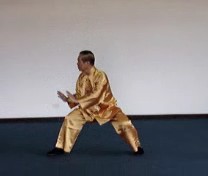
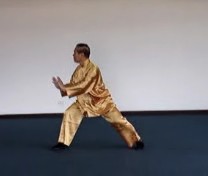

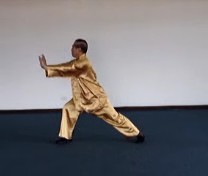
These Grasping Sparrow's Tail movements can be viewed in video clips at the beginning of the Wahnam Taijiquan Simplified Set
in slow motion
performed with force and speed































